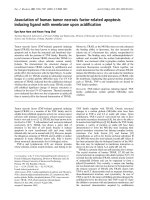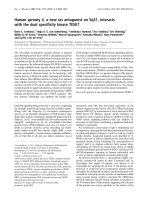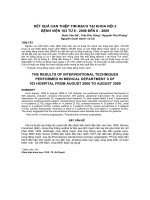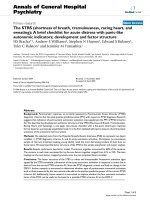Báo cáo y học: "Inexperienced clinicians can extract pathoanatomic information from MRI narrative reports with high reproducibility for use in research/quality assurance" pdf
Bạn đang xem bản rút gọn của tài liệu. Xem và tải ngay bản đầy đủ của tài liệu tại đây (838.89 KB, 10 trang )
RESEARC H Open Access
Inexperienced clinicians can extract
pathoanatomic information from MRI narrative
reports with high reproducibility for use in
research/quality assurance
Peter Kent
1*
, Andrew M Briggs
2
, Hanne B Albert
1
, Andreas Byrhagen
3
, Christian Hansen
4
, Karina Kjaergaard
5
and
Tue S Jensen
1
Abstract
Background: Although reproducibility in reading MRI images amongst radiologists and clinicians has been studied
previously, no studies have examined the reproducibility of inexperienced clinicians in extracting pathoanatomic
information from magnetic resonance imaging (MRI) narrative reports and transforming that information into
quantitative data. However, this process is frequently required in research and quality assurance contexts. The
purpose of this study was to examine inter-rater reproducibility (agreement and reliability) among an inexperienced
group of clinicians in extracting spinal pathoanatom ic information from radiologist-generated MRI narrative reports.
Methods: Twenty MRI narrative reports were randomly extracted from an institutional database. A group of three
physiotherapy students independently reviewed the reports and coded the presence of 14 common
pathoanatomic findings using a categorical electronic coding matrix. Decision rules were developed after initial
coding in an effort to resolve ambiguities in narrative reports. This process was repeated a further three times
using separate samples of 20 MRI reports until no further ambiguities were identified (total n = 80). Reproducibility
between trainee clinicians and two highly trained raters was examined in an arbitrary coding round, with
agreement measured using percentage agreement and reliability measured using unweighted Kappa (k).
Reproducibility was then examined in another group of three trainee clinicians who had not participated in the
production of the decision rules, using another sample of 20 MRI reports.
Results: The mean percentage agreement for paired comparisons between the initial trainee clinicians improved
over the four coding rounds (97.9-99.4%), although the greatest improvement was observed after the first
introduction of coding rules. High inter-rater reproducibility was observed between trainee clinicians across 14
pathoanatomic categories over the four coding rounds (agreement range: 80.8-100%; reliability range k = 0.63-
1.00). Concurrent validity was high in paired comparisons between trainee clinicians and highly trained raters
(agreement 97.8-98.1%, reliability k = 0.83-0.91). Reproducibility was also high in the second sample of trainee
clinicians (inter-rater agreement 96.7-100.0% and reliability k = 0.76-1. 00; intra-rater agreement 94.3-100.0% and
reliability k = 0.61-1.00).
Conclusions: A high level of radiological training is not required in order to transfo rm MRI-derived pathoanatomic
information from a narrative format to a quantitative format with high reprodu cibility for research or quality
assurance purposes.
Keywords: MRI, narrative report, coding, spine, pathoanatomy
* Correspondence:
1
Research Department, Spine Centre of Southern Denmark, Lillebaelt
Hospital, Institute of Regional Health Services Research, University of
Southern Denmark, Middelfart, Denmark
Full list of author information is available at the end of the article
Kent et al. Chiropractic & Manual Therapies 2011, 19:16
/>CHIROPRACTIC & MANUAL THERAPIES
© 2011 Kent et al; licensee BioMed Central Ltd. This is an Open Access article distributed under the terms of the Creative Commons
Attribution License ( which permits unrestricted use, distribution, and reproduction in
any medium, provided the original work is p roperly cited.
Background
Magnetic resonance imaging (MRI) is considered the
gold standard modality for imaging spinal structures in
vivo [1]. Spinal pathoanatomy may be readily visualised
using MRI and some pathoanatomic features, such as
tumours, fractures, infections and nerve root compres-
sion, are usually clinically important. On the other hand,
the clinical relevance of some other spinal pathoana-
tomic features, particularly their association with spinal
pain and other symptoms, remains uncertain and is an
ongoing topic of debate [2-4]. Although further explora-
tion of this issue may be warranted, particularly in the
context of vertebral endplate signal changes, which have
shown an association with pain [5], a prerequisite for
such investigations is the reliable extraction of informa-
tion from MRI images.
Quantitative coding of MRI findings is important
where such data are used for research and quality assur-
ance purposes. For example, narrative MRI reports need
to be routi nely transformed into quantitative data wi thin
the context of clinical trials, cohort studies and health
registries. Although such quantification can be performed
directly by experienced radiologists who have been
trained in the relevant research protocols, this is often
not practical because there is a widespread shortage of
experienced radiologists, especially research radiologists,
and their participatio n is usually expensive. Therefore, an
alternative pathway is for MRI findings to be quantified
from narrative reports dictated by radiologists.
There are two important interpretative steps in the
pathway from acquiring spinal MR images to a quantifi-
cation of any identified pathoanatomic findings. Repro-
ducibility (agree ment and reliability) in each step is
important for best practice research. First, radiologists
need to interpret the scan images and dictate a narrative
report that adequately describes the relevant normal and
abnormal pathoanatomic findings. Several stu dies have
described the inter-radiologist reliability of this process
as typically being fair to substantial (Kappa’ sranging
from 0.21 to 0.80) [1,6-8]. Second, researchers who
review narrative reports need to extract important
pathoanatomic findings in a consistent manner.
Although earlier research has identified comparable
reproducibility between radiologists and spinal surgeons,
neurosurgeons and conservative-care clinicians in read-
ing spinal MR images [1], the reproducibility o f
researchers in extracting information from MRI narra-
tive reports and transforming this information into a
quantitative format has not been evaluated previously.
It remains uncertain as to what level of clinical training
is require d to extract pertinent pathoanatomic informa-
tion from narrative reports with adequate reproducibility
for research/quality assurance purposes. Therefore, the
aim of this study was to quantify the reproducibility of an
inexperienced group of trainee clinicians in extracting
pathoanatomic information from MRI narrative reports.
Methods
Design
A repeated measures study was performed to investigate
inter-rater reproducibility in transforming pathoanatomic
information from narrative MRI reports into quantitative
data. Two groups of three final y ear (third y ear) phy-
siotherapy students who had received minimal training in
interpreting MRI narrative reports were engaged as inde-
pendent raters. They had only received two lectures intro-
ducing them to the broad array of imaging techniques.
The study was covered by a quality assurance approval by
the Scientific Ethics Committee of Southern Denmark and
complied with the Declaration of Helsinki (2008).
Conceptually, reproducibility contains two compo-
nents - agreement and reliability [9]. Agreement is
about measurement error and quantifies the similarity
of scores obtained by repeated measurement. This is a
useful measure when the measurement tool and mea-
surement process being examined are to be used for
monitoring change over time. Reliability is about how
well the measurement tool and measurement process
areabletodistinguish between subjects or objects (for
examplepeopleorpathologies),despitethemeasure-
ment error. Reliability is influenced by the variability in
the scores. Therefore, reliability may vary within a study
population (for example from one body region to
another) or be tween study populatio ns, even though the
measurement error remains the same [9].
Imaging
In the MRI unit of the Spine Centre of Southern Den-
mark, there were narrative reports of lumbar MRIs
available for a total of 4,233 community-dwelling indivi-
duals who had attended the Centre over the previous 8
years. MRIs of other body regions o r repeat lumbar
MRIs for individuals were not included in that sample.
This spine centre is a publicly-funded secondary care
outpatient facility special ising in the diagnosis and man-
agement of spinal pain, and is located on the island of
Funen, Denmark. Patients were re ferred to the Centre
by primary care chiropractors an d general practitioners
between the years 2000 and 2008.
A standard lumbar MRI protocol utilising a 0.2 T MRI
system (Magnetom Open Viva, Siemens AG, Erlangen,
Germany) was used. All patients were placed in the
supine position with straightened legs. The imaging pro-
tocol consisted of one localiser and four imaging
sequences - T1 and T2 sagittal and axial images (more
detail is available on request from the authors).
Kent et al. Chiropractic & Manual Therapies 2011, 19:16
/>Page 2 of 10
Axial images were performed on the three lower lum-
bar levels. If serious pathology were present or hernia-
tions were located at higher lumbar levels, relevant
supplementary sequences were performed. All images
over this eight-year period were read by either one of
two experienced musculoskeletal radiologists.
Coding of MRI narrative reports
An electronic coding matrix was developed for this
study using F ileMaker Pro 9 (FileMaker Inc, CA, USA).
The coding matrix was designed to facilitate data cap-
ture for subsequent research projects. This coding
matrix was used by the three raters to transform find-
ings from narrative reports into a quantitative measure
(yes/no score) of the presence of 14 possible pathologies
including: intervertebral disc degeneration, disc bulge,
disc herniation, nerve root compromise, Modic change
type 1, Modic change type 2 , spondylolisthesis (anterior
or retro) with or without spondylolysis, stenosis, scolio-
sis, osteophytes, facet joint arthrosis, other endplate irre-
gularities (including Scheuerm ann defects, irregularities),
red flags (tumour, fracture, infection), and hig h intensity
zones (Figure 1). These pathologies were chosen as they
were pertinent to research undertaken in the study con-
text. Other pathologies may have been reported in the
narrative reports, but as they were not relevant to our
research, they were not coded by the raters. The raters
use d the matrix to indicat e whether pathoanatomic fea-
tures were reported as present between vertebral levels
T12-L5, including an option to nominate compromise
of the S1 nerve root. For the purpose of coding, a ver-
tebral segment was defined as extending from the super-
ior vertebral endplate to the caudal aspect of the
intervertebral space below, for example the T12 vertebra
and T12/L1 inter-vertebral space.
An initial s ample of 20 reports (0.47%) was randomly
selected from all the people in the database who shared
the same weekday of their date of birth. All coding was
performed independently by the first group of three
raters who remained blinded to each other’ sscores
throughout the study. As each rater coded each MRI,
whenever a narrative report finding was considered
Figure 1 Screen shot of electronic coding matrix, consisting of 14 pathoanatomic categories for coding a narrative MRI report.
Kent et al. Chiropractic & Manual Therapies 2011, 19:16
/>Page 3 of 10
ambiguous, the rater(s) noted that ambiguity on a log
sheet and selected the pathoanatomic feature in the cod-
ing matrix that they believed to be the most appropriate.
At the completion of this initial cycle of coding 20
reports (a coding round), ambiguous report findings
were collated and decision rules developed by senior
researchers to provide a consistent decision-making pro-
cess between raters. This group of inexperienced raters
was able to contribute to the formation of the coding
rules and provide feedback on their utility.
The initial coding round was undertaken without any
decision rules. Another separate sample of 20 MRI
reports of p eople who shared a different birth day was
then selected and this process wa s repeated until no
further ambiguities in reporting were identified b y the
raters. Three iterations of the coding rules were devel-
oped, therefore the total number of MRIs used was 80
(1.9% of the total available sample). The final set of
decision rules is included as Additional file 1. In the
first round of coding, three categories were not included
in the matrix (’other endplate irregularities’ , ‘red flags’,
and ‘high intensity zones’) but were added in the second
round to refine the specificity of findings.
The choice of 20 MRI reports per round was arbitrary
as we had no data apriorion which to estimate the
likely reliability between raters and its variance, nor the
likely proportions of positive diagnoses. Therefore, we
performed a post hoc power calculation to determine
the reliability that was statistically detectable, given the
sample size, Kappa values, and observed proportion of
positive diagnoses, using the met hod described by Sim
and Wright [10].
Inter-rater reproducibility
Inter-rater reproducibility was calculated separately for
coding rounds 1 to 4. Given the uncertainty as to what
level of clinical training was required to achieve ade-
quate reproducibility in e xtracting pathoanatomic infor-
mation from the narrative reports, we co mpared the
reproducibility of the three trainee clinicians to that of
two highly trained raters during an arbitrary coding
round (round two). The two highly trained raters were
experienced researchers in the field of spinal MRI,
including designing and conducting reproducibility stu-
dies of lumbar MRI findings [11,12]. One was a chiro-
practor and the other a physiotherapist, both of whose
PhDs and post-doctoral experience focused on the
investigation of MRI findings.
Inter-rater reproducibility was also calculated for the
coding round that involved the second group of three
trainee clinicians. These raters were exposed to the cod-
ing rules but did not participate in rule formation. Their
training consisted solely of rece iving feedback on their
reproducibility when coding five r andomly selected MRI
reports not used in the coding rounds in t his study.
Therefore, their performance was more representative of
the reproducibility that might be achievable if these cod-
ing rules were used in other clinical or research settings.
Intra-rater reproducibility (test-retest)
The second gro up of trainee clinicia ns also recoded the
same 20 MRI reports one week after their initial coding
round. They were blinded to their initial coding s cores.
These two se ts of coding results were used to calcul ate
intra-rater reproducibility.
Data Analysis
The raw coding data were exported from the Filemaker
Pro 9 database into Microsoft Excel 2008 (Microsoft
Corp, Redmond, WA, USA). This allowed the coding
matrices for each MRI report to be aligned according to
rater.
Inter-rater and intra-rater agreement were quantified
using percentage agreement. Percentage agreement
expresses the proportion of cases where there wa s agree-
ment b etween the two raters’ responses, that is, where
both raters nominated the presence of a particular condi-
tion or concurred on the absence of a that condition. It
was calculated with a method reported in other reliability
studies of MRI findings [12-14] using Microsoft Excel
2008. This method involved : (a) summing the number of
agreements in each paired comparison, (b) expressing
that sum as a proportion (percentage) of the number of
ratings, (c) repeating this for all possible pairs of raters in
that coding round, and (d) calculating t he mean and 95%
confidence interval of those proportions to provide a sin-
gle estimate of the percentage agreement for that coding
round.
Inter-rater and intra-rater reliability was quantified
using the unwei ghted Kappa stati stic. The Kappa coeffi-
cient expresses reliability for nominal or ordinal ratings
while accounting for chance agreement [15]. The magni-
tude of Kappa can be influenced by prevalence of the
condition, bias and non-independence of ratings [10]
Kappa coefficients were calculated using the ‘kap’ and
‘kapci’ proced ures in STATA 10.1 (Stata Corp, College
Station, Texas, USA). We used a STATA program (do-
file) that automated the process of: (i) calculating Kappa
for all the possible paired comparisons, (ii) averaging
Kappa values by first transforming them int o Z-scores
(Fisher’ s transformation), (iii) finding the arithmetic
mean and ca lculating the 95% confidence interval, and
then (iv) transforming the results back into Kappa
values. Consistent with recommendations in the litera-
ture [6,16,17], the program did not calculate Kapp a
whentheprevalenceofapathoanatomicfindingwas
less than 10% or greater than 90%, as in situations of
ver y high or very low prevalence, the chance agreement
Kent et al. Chiropractic & Manual Therapies 2011, 19:16
/>Page 4 of 10
increases and biases the value of Kappa [18]. In the cur-
rent study, this restriction applied to the prevalence of
the pathology at each and every vertebral level being
compared, and for findings of all raters being compared.
Agreement (percentage agreement) and reliability
(Kappa) were also calculated between the highly trained
raters and between the highly trained raters and trainee
clinicians. Comparisons between highly trained raters
and trainee clinicians represent a measure of concurrent
validity.
Percentage agreement and Kappa were calculated in two
ways: (1) using only the ratings for each separate pathology
to allow comparisons of reproducibility between patholo-
gies, and (2) using all the ratings across all pathologies to
give a global summary statistic. For the calculation of per-
centage agreement and Ka ppa for each patholo gy, there
were between 120 (one pathology × 6 vertebral levels × 20
MRI reports) and 140 ratings (only for nerve root irrita-
tion, one pathology × 7 vertebral levels × 20 MRI reports)
in each pair-wise comparison between inexperienced
raters in each coding round. This method was used when
determining the inter-rater or intra-rater reproducibility of
either group of trainee clinicians.
To calcul ate a global summary statistic for either per-
centage agreement or Kappa, all the ratings for a coding
round were used in a single comparison. This was a
total of 1700 potential ratings in each pair -wise cross-
pathology comparison between raters for each round
((12 pathologies × 6 vertebral levels + nerve root irrita-
tion × 7 vertebral levels) × 20 MRI reports = 1700).
This method was used when determining the reproduci-
bility between the highly trained raters and also between
the highly trained raters and trainee clinicians, as
although this summary statistic provi des less detail, it is
easier to interpret.
The prevalence for each pathology was calculated for
each coding round. This was performed on a ‘ whole
person’ level, that is, where the p resence of a particular
pathology in a person at one or more vertebral levels
was counted as a single instance.
Results
TheaverageageofthepeoplewhoseMRIswere
included was 51.4 years (SD 13.1; full range 27 to 88),
and 55.0% were female. The prevalence of the 14
pathoanatomic categories within each sample of 20 MRI
scans ranged from 0.0% to 100.0% (Tables 1 and 2). All
pathologies were present in at least one of the five cod-
ing rounds.
Reproducibility during the formation of the coding rules
Overall, the mean paired-comparison percentage agree-
ment between the initial three trainee clinicians across
the 14 pathoanatomic categories increased with each
subsequent round of coding from 97.9% to 99.4%. Over-
all, across the 14 categories and four rounds of coding,
their inter-rate r a greemen t (percentage agreement) ran-
ged from 80.8%-100%, and reliability (Kappa) ranged
from 0.63-1.00 (Table 1). The inter-rater reproducibility
between highly trained raters determined in a single cod-
ing round, expressed as percentage agreement (95% CI)
was 97.3% (96.6-98.1%) and Kappa (95% CI) was 0.82
(0.77-0.86). Kappa coefficients grea ter than 0.80 are gen-
erally considered to represent excellent reliability [19].
For the round in which the initial trainee clinicians
were compared with highly trained raters, the mean per-
centage agreement between the trainee clinicians and
highly trained rater 1 was 97.8% (9 7.0%-98.7%) and with
highly trained rater 2 wa s 98.1% (96.7%-99.5%), suggest-
ing excellent agreement. The Kappa c oefficients ranged
from 0.83-0.87 for comparisons between these trainee
clinicians and highly trained rater 1, and 0.83-0.91 when
compared with highly trained rater 2, (Table 2).
Reproducibility in inexperienced clinicians trained with
the final set of coding rules
Overall, across the 14 categories and single round of
coding, the second group of inexperienced clinicians dis-
played an inter-rater agreement (percentage agreement)
ranging from 96.7-100.0% and their reliability (Kappa)
ranged from 0.76-1.00 (Table 3). Their test-retest repro-
ducibility was also high, with intra-rater agreement ran-
ging from 94.3-100.0% and reliability ranging from k =
0.61-1.00.
Sample size
Post-hoc observations showed that across all patient
MRI reports, all pathologies and all vertebral levels, the
rater endorsement of the presence of a pathology was
approximately 8%. A post-hoc powe r calculation showed
that on the basis of an observed proportion of positive
diagnoses (rater endorsement) of 10%, and an assumed
null hypothesis value of Kappa to be 0.40, then a sample
size of 102 ratings would detect with 80% power, a sta-
tistically significant Kappa of 0.90. As the sample sizes
used in this study for the calculation of Kappa usually
ranged between 120 and 140 observations (within
pathology comparisons), and for some calculations was
as large as 1700 observations (across all pathology com-
parisons), there was adequate power in the sample.
Discussion
This study is the first to establish that inter-rater and
intra-rater reproducibility in extracting pathoanatomic
information from MRI narrative reports is excellent.
Moreover, we have demonstrated that a high level of
radiological experience is not required to perform this
task well, even in the absence of coding rules. These
Kent et al. Chiropractic & Manual Therapies 2011, 19:16
/>Page 5 of 10
findings have useful implications for conducting large-
scale research and quality assurance projects that
include MRI data.
Agreement b etween the initial group of trainee clini-
cians exceeded a percentage agreement of 90%, except
for intervertebral disc degeneration in coding round 1
(80.8%). The greater discordance between raters for
intervertebral disc degeneration may be explained by the
larger number of terms used by radiologists to charac-
terise degeneration, relative to other pathoanatomic
findings. Nonetheless, with the introduction of coding
rules, the percentage agreement for this category
increased to a maximum of 98.2% and was comparable
to that of highly trained raters (97.3%). The greatest
Table 1 Inter-rater reproducability results for the initial group of three trainee clinicians for 14 pathoanatomic
categories across the four coding rounds, expressed as a Kappa co-efficient and percentage agreement with 95%
confidence intervals (95% CI)
Pathoanatomic category Reliability index (95%CI) Coding round 1 Coding round 2 Coding round 3 Coding round 4
Intervertebral disc degeneration Prevalence*
Kappa
Percentage agreement
71.7% (50.2-93.1)
0.66 (0.54-0.77)
80.8% (73.8-87.9)
94.0 (92.0-96.0)
0.94 (0.84-1.00)
95.8 (92.3-99.4)
80.0 (80.0-80.0)
n/a
98.2 (95.8-100.0)
83.3 (80.1-86.6)
0.91 (0.80-1.00)
97.5 (94.7-100.0)
Intervertebral disc bulge Prevalence
Kappa
Percentage agreement
73.3% (70.1-76.6)
0.91 (0.78-1.00)
95.0% (94.7-100.0)
87.0 (83.1-90.9)
0.86 (0.76-0.90)
92.5 (87.7-97.2)
70.0 (70.0-70.0)
1.00 (0.87-1.00)
100.0
48.3 (45.1-51.6)
0.89 (0.76-1.00)
99.2 (97.5-100.0)
Intervertebral disc herniation Prevalence
Kappa
Percentage agreement
40.0% (34.3-45.7)
0.91 (0.73-1.00)
97.5% (94.7-100.0)
61.0 (59.0-63.0)
1.00 (0.85-1.00)
100.0
40.0 (40.0-40.0)
0.98 (0.87-1.00)
96.5 (93.1-99.9)
45.0 (45.0-45.0)
1.00 (0.82-1.00)
100.0
Nerve root compromise Prevalence
Kappa
Percentage agreement
13.3% (4.7-22.0)
n/a
97.5% (94.7-100.0)
42.0 (31.9-52.1)
0.74 (0.49-1.00)
94.2 (90.0-98.4)
31.7 (23.0-40.3)
0.63 (0.45-0.81)
93.0 (88.3-97.7)
18.3 (15.1-21.6)
1.00 (0.75-1.00)
99.2 (97.5-100.0)
Modic change type 1 Prevalence
Kappa
Percentage agreement
26.7% (23.4-29.9)
0.86 (0.68-1.00)
95.0% (91.1-98.1)
18.0 (15.6-20.4)
0.86 (0.60-1.00)
98.3 (96.0-100.0)
20.0 (20.0-20.0)
1.00 (0.82-1.00)
100.0
18.3 (15.1-21.6)
0.86 (0.60-1.00)
100.0
Modic change type 2 Prevalence
Kappa
Percentage agreement
25.0% (19.3-30.7)
0.76 (0.51-1.00)
97.5% (94.7-100.0)
10.0 (5.6-14.4)
n/a
98.3 (96.0-100.0)
20.0 (20.0-20.0)
1.00 (0.82-1.00)
100.0
5.0 (5.0-5.0)
n/a
100.0
Spondylolisthesis Prevalence
Kappa
Percentage agreement
20.0% (20.0-20.0)
n/a
97.5% (94.7-100.0)
19.0 (17.0-21.0)
1.00 (0.75-1.00)
100.0
10.0 (10.0-10.0)
1.00 (0.82-1.00)
100.0
0.0 (0.0-0.0)
n/a
100.0
Stenosis Prevalence
Kappa
Percentage agreement
6.7% (3.4-9.9)
n/a
97.5% (94.7-100.0)
23.0 (20.6-25.4)
0.84 (0.59-1.00)
99.2 (97.5-100.0)
25.0 (25.0-25.0)
0.95 (0.74-1.00)
99.1 (97.4-100.0)
0.0 (0.0-0.0)
n/a
100.0
Scoliosis Prevalence
Kappa
Percentage agreement
25.0% (25.0-25.0)
1.00 (0.82-1.00)
100.0%
6.0 (4.0-8.0)
n/a
95.0 (91.1-98.9)
5.0 (5.0-5.0)
n/a
99.1(97.4-100.0)
5.0 (5.0-5.0)
n/a
100.0
Osteophytes Prevalence
Kappa
Percentage agreement
5.0% (5.0-5.0)
n/a
100.0%
1.0 (0.0-3.0)
n/a
100.0
10.0 (10.0-10.0)
n/a
99.1 (97.4-100.0)
10.0 (10.0-10.0)
1.00 (0.75-1.00)
99.2 (97.5-100.0)
Facet joint arthrosis Prevalence
Kappa
Percentage agreement
0.0% (0.0)
n/a
100.0%
14.0 (12.0-16.0)
0.68 (0.42-0.93)
95.0 (91.1-98.9)
20.0 (20.0-20.0)
1.00 (0.82-1.00)
100.0
5.0 (5.0-5.0)
n/a
100.0
Endplate irregularities Prevalence
Kappa
Percentage agreement
#
1.0 (0.0-3.0)
n/a
99.2 (97.5-100.0)
25.0 (19.3-30.7)
1.00 (0.82-1.00)
98.2 (95.8-100.0)
18.3 (11.8-24.9)
0.74 (0.56-0.92)
97.5 (94.7-100.0)
Red flags Prevalence (%)
Kappa
Percentage agreement
#
0.0 (0.0-0.0)
n/a
100.0
8.3 (1.8-14.9)
n/a
98.2 (95.8-100.0)
0.0 (0.0-0.0)
n/a
100.0
High intensity zone Prevalence (%)
Kappa
Percentage agreement
#
15.0 (11.9-18.1)
0.84 (0.59-1.00)
99.2 (97.5-100.0)
26.7 (20.1-33.2)
0.85 (0.67-1.00)
98.2 (95.8-100.0)
25.0 (25.0-25.0)
1.00 (0.82-1.00)
100.0
* The prevalence estimates are calculated on a ‘whole person’ level. That is, the presence of a particular pathology in a person at one or more vertebral levels
was counted as a single instance.
95%CI = 95% confidence interval in brackets.
#
not included in coding round 1.
n/a = kappa co-efficient not calculated. Calculation of kappa in STATA requires the prevalence of the pathology to be 10% to 90% at each and every vertebral
level being compared. This restriction appl ies to the findings of all raters being compared.
Kent et al. Chiropractic & Manual Therapies 2011, 19:16
/>Page 6 of 10
improvement in inter-rater agreement for inter vertebral
disc degeneration was observed after the first introduc-
tion of coding rules (round 2). This observation is con-
sistent with the improvement in the mean percentage
agreement across the 14 pathoanatomic categories also
being largest between coding rounds 1 and 2 (0.8%).
Although the mean percentage agreement continued to
improve with t he two subsequent iterations of the cod-
ing rules, the improvements were relatively minor ( 0.3-
0.4%), indicating only a small additional training effect.
This suggests that the initial version of coding rules was
sufficient to improve reliability by the greatest extent.
By the fourth coding round, the percentage agreement
exceeded 99.0% in all categories except for ‘interverteb-
ral dis c degeneration’ and ‘ other endplate irregularities’.
These results were reinforced by those of the second
group of inexperienc ed clinicians who displayed a mean
inter- rater percentage agreement of 99.0% and mean
intra-rater percentage agreement of 98.7%.
Similarly, the levels of reliability (Ka ppa coefficients)
achieved by the fourth coding round for the first group
of inexperienced clinicians exceeded 0.85 in all categories
other than for ‘endplate irregularities’, which would all be
classified by the Landis criteria as showing excellent relia-
bility [19]. In addition to the lower Kappa value observ ed
for intervertebral disc degeneration in coding round 1, a
lower value was also observed for nerve root compromise
in coding round 3. Similar to disc degeneration, greater
discordance for nerve root compromise and also for end-
plate irregularities might be explained by a relatively lar-
ger number of terms used to describe these findings.
These results were also reinforced by those obtained by
the second group of inexperienced clinicians. Their inter-
rater Kappa coefficients all exceeded 0.92, except for
‘ nerve root compromise’ and their intra-rater Kappa
coefficients all exceeded 0.88, except for ‘nerve root com-
promise’ and ‘disc bulge’ . To our knowledge, no other
studies have explored the reproducibility of this task and
therefore it is not possible to compare our result s with
those reported in other literature.
As the level of training required to transform narrative
MRI reports to quantita tive data was uncertain, this
study compared inter-rater reproducibility between a
group of trainee clinicians and highly trained MRI
coders. The results suggest that trainee clinicians dis-
played equal reproducibility as experienced researchers
in performing this task, when trained with simple cod-
ing rules. Collectively, these data suggest that with mini-
mal training and t he introduction of basic coding rules,
trainee clinicians can accurately and reliably extract
pathoanatomic information from MRI narrative reports.
In the absence of radiologists being availab le to quan-
tify pathoanatomic findings directly from an MRI con-
sole, having other personnel quantify these findings
from narrative reports is the next best alternative, parti-
cularly in the context of workforce limitations and lim-
ited budgets for research projects. Our evidence that
inexp erienced clinicians can perform this task with high
reproducibility has implications for the planning, feasi-
bility and cost of research and quality assurance activ-
ities. However, these findings are derived within a
research/quality assurance context and should not be
inferred to have implications for clinical practice. Exami-
nation of the reliability of inexperienced clinicians at
extracting clinically relevant information from MRI
reports was not part of the current study.
Another potential alternative is to create software that
could screen narrative reports for key phrases, and
thereby, automate the process of coding pathoanatomic
findings. However, this would need to overcome the
challenge of the disparate and inconsistent ways in
which radiologists report the same findings and ideally
would need to be shown to have at least comparable
reproducibility as human raters.
The design of this study has three strengths. First, the
electronic coding matrix contai ned an extensive list of
common pathoanatomic observations reported in MRI
narrative reports. The matrix also provided an efficient
and dependable mechanism to enter and store data. Sec-
ond, we established reproducibility using a group of
Table 2 Inter-rater reproducability between trainee clinicians and highly trained raters within a single coding
round, expressed as a paired-comparison percentage agreement and Kappa co-efficient with 95% confidence intervals
(95% CI)
Paired comparison Percentage agreement (95% CI) Kappa (95% CI, p value)
Highly trained rater 1 × Trainee clinician 1 98.2% (97.5%-98.8%) 0.87 (0.82-0.91)
Highly trained rater 1 × Trainee clinician 2 97.8% (97.2%-98.5%) 0.85 (0.79-0.89)
Highly trained rater 1 × Trainee clinician 3 97.5% (96.8%-98.2%) 0.83 (0.77-0.87)
Mean 97.8% (97.0%-98.7%)
Highly trained rater 2 × Trainee clinician 1 98.1% (97.4%-98.7%) 0.87 (0.82-0.90)
Highly trained rater 2 × Trainee clinician 2 97.5% (96.8%-98.2%) 0.83 (0.77-0.87)
Highly trained rater 2 × Trainee clinician 3 98.6% (98.1%-99.2%) 0.91 (0.86-0.94)
Mean 98.1% (96.7%-99.5%)
Kent et al. Chiropractic & Manual Therapies 2011, 19:16
/>Page 7 of 10
trainee clinicians in order to determine whether this
task could be performed well by a relatively inexper-
ienced group of people, as this reflects common work-
force characteristics in large research projects. We then
compared their level of reproducibility to that of highly
trained researchers. Thirdly , we replicated the findings
in a new group of trainee clinicians that did n ot
participate in establishing the coding rules, thereby
extending the generalisability of the results.
These results should, however, be considered in the
context of some limitations. The number of MRI reports
used in each coding round (n = 20) was chosen arbi tra-
rily and might be considered small. However, depending
on the pathologies and vertebral levels involved in each
Table 3 Inter-rater reproducability reliability results for the second group of three trainee clinicians for 14
pathoanatomic categories across a single coding round, expressed as a Kappa co-efficient and percentage agreement
with 95% confidence intervals (95% CI)
Pathoanatomic category Reliability index (95%CI) Inter-rater
Coding round 1
Inter-rater
Coding round 2
Test-retest
(intra-rater)
Intervertebral disc degeneration Prevalence*
Kappa
Percentage agreement
90.0% (90.0-90.0)
0.99 (0.87-1.00)
99.3% (99.0-100.0)
90.0% (90.0-90.0)
0.93 (0.82-1.00)
96.7% (95.0-99.0)
-
0.88 to 1.00
97.3% (94.0-100.0)
Intervertebral disc bulge Prevalence
Kappa
Percentage agreement
90.0% (90.0-90.0)
0.96 (0.84-1.00)
98.0% (97.0-99.0)
85.0% (79.3-90.7)
0.93 (0.80-1.00)
96.7% (95.0-99.0)
-
0.79 to 0.96
94.3% (91.0-97.0)
Intervertebral disc herniation Prevalence
Kappa
Percentage agreement
58.3% (55.1-61.6)
0.94 (0.80-1.00)
98.7% (98.0-99.0)
58.3% (55.1-61.6)
0.94 (0.80-1.00)
98.7% (98.0-100.0)
-
0.86 to 0.91
97.3% (97.0-98.0)
Nerve root compromise Prevalence
Kappa
Percentage agreement
53.3% (50.1-56.6)
0.76 (0.58-0.94)
96.0% (94.0-98.0)
55.0% (49.3-60.7)
0.81 (0.63-0.99)
97.3% (96.0-98.0)
-
0.61 to 0.86
95.3% (94.0-98.0)
Modic change type 1 Prevalence
Kappa
Percentage agreement
20.0% (20.0-20.0)
1.00 (0.82-1.00)
100.0% (100.0-100.0)
21.7% (18.4-24.9)
0.93 (0.75-1.00)
99.3% (99.0-100.0)
-
0.89 to 1.00
99.7% (99.0-100.0)
Modic change type 2 Prevalence
Kappa
Percentage agreement
10.0% (10.0-10.0)
1.00 (0.75-1.00)
100.0% (100.0-100.0)
8.3% (5.1-11.6)
n/a
99.3% (99.0-100.0)
-
1.00 to 1.00
99.7% (99.0-100.0)
Spondylolisthesis Prevalence
Kappa
Percentage agreement
20.0% (20.0-20.0)
1.00 (0.75-1.00)
100.0% (100.0-100.0)
20.0% (20.0-20.0)
1.00 (0.75-1.00)
100.0% (100.0-100.0)
-
1.00 to 1.00
100.0% (100.0-100.0)
Stenosis Prevalence
Kappa
Percentage agreement
16.7% (13.2-19.9)
n/a
99.3% (99.0-100.0)
15.0% (15.0-15.0)
n/a
100.0% (100.0-100.0)
-
n/a
99.7% (99.0-100.0)
Scoliosis Prevalence
Kappa
Percentage agreement
5.0% (5.0-5.0)
n/a
100.0% (100.0-100.0)
5.0% (5.0-5.0)
n/a
100.0% (100.0-100.0)
-
n/a
100.0% (100.0-100.0)
Osteophytes Prevalence
Kappa
Percentage agreement
0.0% (0.0-0.0)
n/a
100.0% (100.0-100.0)
0.0% (0.0-0.0)
n/a
100.0% (100.0-100.0)
-
n/a
100.0% (100.0-100.0)
Facet joint arthrosis Prevalence
Kappa
Percentage agreement
15.0% (15.0-15.0)
1.00 (0.82-1.00)
100.0% (100.0-100.0)
15.0% (15.0-15.0)
0.92 (0.74-1.00)
98.7% (98.0-100.0)
-
0.88 to 1.00
99.3% (98.0-100.0)
Endplate irregularities Prevalence
Kappa
Percentage agreement
5.0% (5.0-5.0)
n/a
100.0% (100.0-100.0)
1.7% (0.0-4.9)
n/a
99.3% (99.0-100.0)
-
n/a
99.3% (99.0-100.0)
Red flags Prevalence
Kappa
Percentage agreement
0.0% (0.0-0.0)
n/a
100.0% (100.0-100.0)
0.0% (0.0-0.0)
n/a
100.0% (100.0-100.0)
-
n/a
100.0% (100.0-100.0)
High intensity zone Prevalence
Kappa
Percentage agreement (%)
15.0% (15.0-15.0)
1.00 (0.75-1.00)
100.0% (100.0-100.0)
15.0% (15.0-15.0)
1.00 (0.75-1.00)
100.0% (100.0-100.0)
-
n/a
100.0% (100.0-100.0)
* The prevalence estimates are calculated on a ‘whole person’ level. That is, the presence of a particular pathology in a person at one or more vertebral levels
was counted as a single instance.
95%CI = 95% confidence interval in brackets.
n/a = kappa co-efficient not calculated. Calculation of kappa in STATA requires the prevalence of the pathology to be 10% to 90% at each and every vertebral
level being compared. This restriction appl ies to the findings of all raters being compared.
Kent et al. Chiropractic & Manual Therapies 2011, 19:16
/>Page 8 of 10
comparison between raters, this resulted in between 120
and 140 observations per rater per round for each
pathology, and a total of 1700 observations per rater per
round across all the pathologies combine d. A post hoc
power calculation showed adequate power to detect the
Kappa values typically observed. Our decision to compare
three t rainee clinicians in each group was also arbitrary
and based on these people also being part of a larger
research programme. Furthermor e, the trainees consisted
of physiotherapy students only. It is possible that these
estimates of reproducibility may vary, depending on the
number of raters and their professional discipline. In this
study, percentage agreement was calculated based on
raters’ nominating the presence of a condition by selecting
a pathoanatomic category and n ominating absence of a
condition by not selecting a pathoanatomic category.
Given there were 85 potential selections per p atient, the
low pr evalence of some pathoanatomic findings resulted
in a large proportion of ‘absent findings’, which may have
inflated inter-rater agreement. However, this approach for
calculating percentage agreement is widely reported in the
literature [12-14]. Another potential limitation is that the
experienced clinicians used for comparison were not radi-
ologists. This was a pragmatic comparison, as it is not
common that research radiologists are available for coding
tasks in large-scale research projects. Therefore the com-
parison clinicians were chosen as r epresentative of
research personnel more commonly available for this task.
Conclusions
Resultsfromthisstudyprovideevidenceofveryhigh
inter-rater and intra-rater reproducibility for inexper-
ienced clinicians in extracting pathoanatomic informa-
tion from MRI narra tive reports. These inexperienced
clinicians also showed high reproducibility compared
with researchers highly trained in this task. Small
improvements in reproducibility can be achieved with
the introduction of coding rules when transforming nar-
rative information to quantitative data. These findings
suggest that for research and quality assurance purposes,
the quantification of pathoanatomic findings contained
in narrative MRI reports can be performed by inexper-
ienced clinicians.
Additional material
Additional file 1: The final set of decision rules used to extract
pathoanatomic findings from MRI narrative reports.
Acknowledgements
We are grateful to Prof Claus Manniche for institutional support. AMB is
supported by a fellowship awarded by the Australian National Health and
Medical Research Council. TSJ is supported by grants from the Danish
Foundation of Chiropractic Research and Postgraduate Education.
Author details
1
Research Department, Spine Centre of Southern Denmark, Lillebaelt
Hospital, Institute of Regional Health Services Research, University of
Southern Denmark, Middelfart, Denmark.
2
School of Physiotherapy and
Curtin Health Innovation Research Institute, Curtin University, Perth, Australia.
3
Odense Physiotherapy Sports and Fitness, Odense, Denmark.
4
Quick Care,
Odense, Denmark.
5
Southwest Jutland Hospital, Esbjerg, Denmark.
Authors’ contributions
All authors participated in the design of the study, its coordination, its
statistical analysis, and read and approved the final manuscript. PK
conceived of the study and designed the database. AMB and PK drafted the
manuscript.
Competing interests
The authors declare that they have no competing interests.
Received: 1 April 2011 Accepted: 21 July 2011 Published: 21 July 2011
References
1. Lurie JD, Doman DM, Spratt KF, Tosteson ANA, Weinstein JN: Magnetic
resonance imaging interpretation in patients with symptomatic lumbar
spine disc herniations. Comparison of clinician and radiologist readings.
Spine 2009, 34:701-705.
2. Dora C, Walchli B, Elfering A, Gal I, Weishaupt D, Boos N: The significance
of spinal canal dimensions in discriminating symptomatic from
asymptomatic disc herniations. Eur Spine J 2002, 11:575-581.
3. Jarvik JJ, Hollingworth W, Heagerty P, Haynor DR, Deyo RA: The
longitudinal assessment of aging and disability of the back (LAIDBack)
study: Baseline data. Spine 2001, 26:1158-1166.
4. Jensen MC, Brant-Zawadzki MN, Obuchowski N, Modic MT, Malkasian D,
Ross JS: Magnetic resonance imaging of the lumbar spine in people
without back pain. N Engl J Med 1994, 331:69-73.
5. Jensen TS, Karppinen J, Sorensen JS, Niinimaki J, Leboeuf-Yde C: Vertebral
endplate signal changes (Modic change): a systematic literature review
of prevalence and association with non-specific low back pain. Eur Spine
J 2008, 17:1407-1422.
6. Arana E, Royuela A, Kovacs FM, Estremera A, Sarasibar H, Amengual G,
Galarraga I, Martinez C, Muriel A, Abraira V, et al: Lumbar Spine:
Agreement in the Interpretation of 1.5-T MR Images by Using the
Nordic Modic Consensus Group Classification Form. Radiology 2010,
254:809-817.
7. Lurie JD, Tosteson AN, Tosteson TD, Carragee E, Carrino JA, Kaiser J,
Sequeiros RT, Lecomte AR, Grove MR, Blood EA, et al: Reliability of
readings of magnetic resonance imaging features of lumbar spinal
stenosis. Spine 2008, 33:1605-1610.
8. Lurie JD, Tosteson AN, Tosteson TD, Carragee E, Carrino JA, Kaiser J,
Sequeiros RT, Lecomte AR, Grove MR, Blood EA, et al: Reliability of
magnetic resonance imaging readings for lumbar disc herniation in the
Spine Patient Outcomes Research Trial (SPORT). Spine 2008, 33:991-998.
9. de Vet HC, Terwee CB, Knol DL, Bouter LM: When to use agreement
versus reliability measures. J Clin Epidemiol 2006, 59:1033-1039.
10. Sim J, Wright CC: The kappa statistic in reliability studies: use,
interpretation, and sample size requirements. Phys Ther 2005, 85:257-268.
11. Jensen TS, Sorensen JS, Kjaer P: Intra- and interobserver reproducibility of
vertebral endplate signal (Modic) changes in the lumbar spine: the
Nordic Modic Consensus Group classification. Acta Radiol 2007,
48:748-754.
12. Sorensen SJ, Kjaer P, Jensen TS, Andersen P: Low field magnetic resonance
imaging of the lumbar spine: Reliability of qualitative evaluation of disc
and muscle parameters. Acta Radiologica 2006, 47:947-953.
13. Carrino JA, Lurie JD, Tosteson AN, Tosteson TD, Carragee EJ, Kaiser J,
Grove MR, Blood E, Pearson LH, Weinstein JN, Herzog R: Lumbar spine:
reliability of MR imaging findings. Radiology
2009, 250:161-170.
14. Mulconrey DS, Knight RQ, Bramble JD, Paknikar S, Harty PA: Interobserver
reliability in the interpretation of diagnostic lumbar MRI and nuclear
imaging. Spine J 2006, 6:177-184.
Kent et al. Chiropractic & Manual Therapies 2011, 19:16
/>Page 9 of 10
15. Altman DG: Some common problems in medical research. Practical
statistics for medical research. London: Chapman & Hall/CRC; 1999.
16. Feinstein AR, Cicchetti DV: High agreement but low kappa: I. The
problems of two paradoxes. J Clin Epidemiol 1990, 43:543-549.
17. Kovacs FM, Royuela A, Jensen TS, Estremera A, Amengual G, Muriel A,
Galarraga I, Martinez C, Arana E, Sarasibar H, et al: Agreement in the
Interpretation of Magnetic Resonance Images of the Lumbar Spine. Acta
Radiologica 2009, 50:497-506.
18. Brennan P, Silman A: Statistical methods for assessing observer variability
in clinical measures. BMJ 1992, 304:1491-1494.
19. Landis JR, Koch GG: The measurement of observer agreement for
categorical data. Biometrics 1977, 33:159-174.
doi:10.1186/2045-709X-19-16
Cite this article as: Kent et al.: Inexperienced clinicians can extract
pathoanatomic information from MRI narrative reports with high
reproducibility for use in research/quality assurance. Chiropractic &
Manual Therapies 2011 19:16.
Submit your next manuscript to BioMed Central
and take full advantage of:
• Convenient online submission
• Thorough peer review
• No space constraints or color figure charges
• Immediate publication on acceptance
• Inclusion in PubMed, CAS, Scopus and Google Scholar
• Research which is freely available for redistribution
Submit your manuscript at
www.biomedcentral.com/submit
Kent et al. Chiropractic & Manual Therapies 2011, 19:16
/>Page 10 of 10
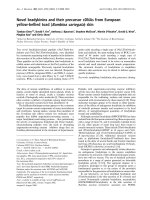
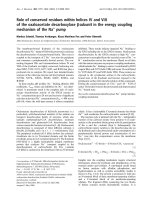

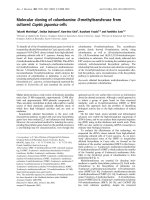
![Báo cáo Y học: The membrane-bound [NiFe]-hydrogenase (Ech) from Methanosarcina barkeri : unusual properties of the iron-sulphur clusters docx](https://media.store123doc.com/images/document/14/rc/ee/medium_eeh1395026426.jpg)
